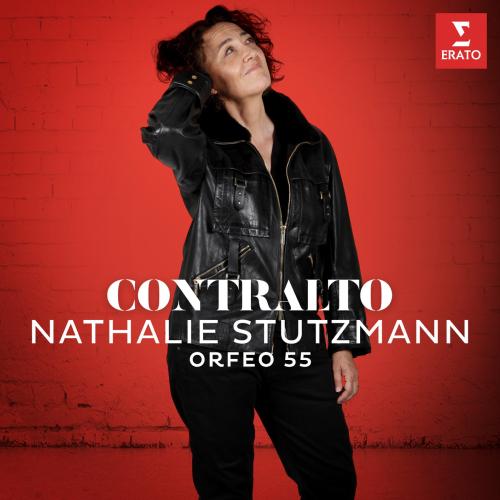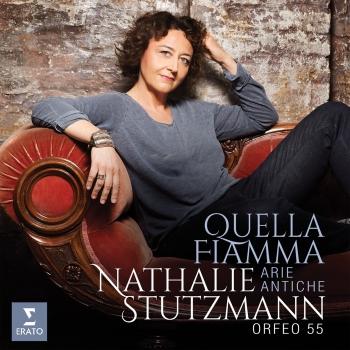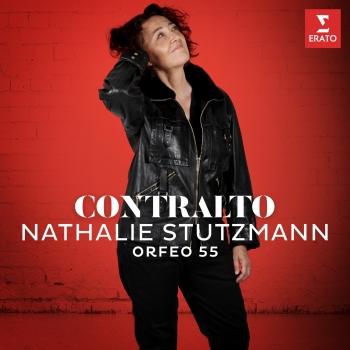
Contralto Nathalie Stutzmann
Album info
Album-Release:
2021
HRA-Release:
15.01.2021
Label: Warner Classics
Genre: Classical
Subgenre: Vocal
Artist: Nathalie Stutzmann
Composer: George Friedrich Händel, Nicola Porpora, Antonio Vivaldi, Giovanni Bononcini, Antonio Lotti, Antonio Caldara, Francesco Gasparini
Album including Album cover Booklet (PDF)
I`m sorry!
Dear HIGHRESAUDIO Visitor,
due to territorial constraints and also different releases dates in each country you currently can`t purchase this album. We are updating our release dates twice a week. So, please feel free to check from time-to-time, if the album is available for your country.
We suggest, that you bookmark the album and use our Short List function.
Thank you for your understanding and patience.
Yours sincerely, HIGHRESAUDIO
- Georg Friedrich Händel (1685 - 1759):
- 1 Handel: Tamerlano, HWV 18, Act I: "Dal crudel che m'ha tradita" (Irene) 03:14
- Nicola Porpora (1686 - 1768):
- 2 Porpora: Meride e Selinunte, Act II: "Torbido intorno al core" (Ericlea) 07:49
- Georg Friedrich Händel:
- 3 Handel: Ariodante, HWV 33: Overture to Act II 01:45
- 4 Handel: Rinaldo, HWV 7b, Act II: "Mio cor, che mi sai dir?" (Goffredo) 02:55
- Antonio Vivaldi (1678 - 1741):
- 5 Vivaldi: Tito Manlio, RV 738, Act I: "Di verde ulivo" (Vitellia) 06:07
- 6 Vivaldi: Farnace, RV 711, Act II: "Gelido in ogni vena" (Farnace) 09:30
- Georg Friedrich Händel:
- 7 Handel: Berenice, HWV 38: Sinfonia to Act III 02:48
- Nicola Porpora:
- 8 Porpora: Semiramide riconosciuta, Act II: "Tradita, sprezzata" (Semiramide) 03:31
- Giovanni Bononcini (1670 - 1747):
- 9 Bononcini: Griselda, Act II: "Caro addio, dal labbro amato" (Griselda) 05:53
- Antonio Lotti (1667 - 1740):
- 10 Lotti: Alessandro Severo: Sinfonia to Act III 01:05
- Georg Friedrich Händel:
- 11 Handel: Arminio, HWV 36, Act I: "Sento il cor per ogni lato" (Ramise) 02:50
- Antonio Caldara (1670 - 1736):
- 12 Caldara: Euristeo, Act III: "Sotto un faggio o lungo un rio" (Erginda) 08:52
- Antonio Vivaldi:
- 13 Vivaldi: Bajazet, RV 703, Act III: "È morto, sì, tiranno... " (Asteria) 01:35
- 14 Vivaldi: Bajazet, RV 703, Act III: "Svena, uccidi, abbatti, atterra" (Asteria) 02:08
- Nicola Porpora:
- 15 Porpora: Statira, Act I: "Mira d'entrambi il ciglio" (Statira) 04:52
- Georg Friedrich Händel:
- 16 Handel: Amadigi di Gaula, HWV 11: Overture - II. Gavotta 01:20
- Francesco Gasparini (1661 - 1727):
- 17 Gasparini: La fede tradita e vendicata, Act II: "Empia mano" (Ernelinda) 05:55
- Georg Friedrich Händel:
- 18 Handel: Sosarme, re di Media, HWV 30, Act II: "Vado, vado al campo" (Erenice) 02:28
- Antonio Vivaldi:
- 19 Vivaldi: L'incoronazione di Dario, RV 719, Sinfonia: I. Allegro 02:27
- 20 Vivaldi: L'incoronazione di Dario, RV 719, Sinfonia: II. Andante e pianissimo 01:47
- 21 Vivaldi: L'incoronazione di Dario, RV 719, Sinfonia: III. Presto 00:34
- 22 Vivaldi: Ginevra principessa di Scozia, RV 716, Act II: "Degli Elisi dal soggiorno" (Lurcanio) 04:03
- Antonio Lotti:
- 23 Lotti: Alessandro Severo: Sinfonia - I. Allegro 01:33
- 24 Lotti: Alessandro Severo: Sinfonia - II. — 01:38
- 25 Lotti: Alessandro Severo: Sinfonia - III. Presto 01:09
- Georg Friedrich Händel:
- 26 Handel: Berenice, HWV 38: Overture - III. Andante larghetto 01:40
- 27 Handel: Rinaldo, HWV 7b, Act III: "Sorge nel petto" (Goffredo) 04:29
Info for Contralto
Contralto Nathalie Stutzmann shines a light on the deep-voiced female singers of the Baroque era, often overshadowed by the extravagant talents and reputations of castrato singers like Farinelli and Caffarelli. Her programme of Handel, Vivaldi, Porpora, Bononcini, Caldara and Gasparini displays the variety of operatic roles – both female and male – assumed by contraltos like Vittoria Tesi and Anna Marchesini. “We must remember that the opera composers of the early 18th century saw the female contralto and the male castrato as vocally interchangeable,” says Stutzmann, “and that the voice most closely resembling a castrato is not the countertenor – produced using a falsetto technique – but the contralto, which is a natural voice.” Stutzmann both sings and conducts Orfeo 55, the instrumental ensemble she founded a decade ago.
Nathalie Stutzmann, conductor
Orfeo 55
Nathalie Stutzmann
is considered to be one of the most outstanding musical personalities of our time, with parallel careers as both contralto and orchestral conductor. Her approach – at once free and rigorous – her knowledge of phrasing and the emotional intensity of her performances has led to huge appreciation, by both the audiences she entertains, as well as the orchestras she leads.
Nathalie Stutzmann sings regularly with the world’s greatest conductors and orchestras, including the Berlin Philharmonic with Sir Simon Rattle, Vienna Philharmonic, Orchestre de Paris, London Symphony Orchestra, and Rotterdam Philharmonic with Yannick Nézet-Séguin.
Fine example of a comprehensive musician, she studied piano, bassoon, chamber music and conducting thoroughly from an early age. In addition to her intense activity as a singer, she devotes part of her career to her commitments as a conductor.
Having studied conducting with the legendary Finnish teacher Jorma Panula and mentored by Seiji Ozawa and Simon Rattle, Nathalie Stutzmann founded her own chamber orchestra, Orfeo 55 in 2009. The orchestra’s permanent home is at the Arsenal in Metz, France, where Nathalie Stutzmann is Artist in Residence. Orfeo 55 plays on both baroque and modern instruments in a wide-ranging repertoire from Bach, Handel, Pergolesi and Vivaldi to Mozart, Beethoven, Wagner, Brahms, Tchaikovsky, Janacek, Richard Strauss and Schoenberg.
Nathalie Stutzmann had the honour of being invited by Seiji Ozawa to share the concert platform with his Mito Chamber Orchestra in January 2014, following her highly successful first visit, in a programme of Beethoven and Mendelssohn and he has invited her to Juku Symphony, for Beethoven’s 8th Symphony and Ravel.
Nathalie Stutzmann has received immediate re-invitations after débuts with leading orchestras including Opera de Monte Carlo: Donizetti’s L’Elisir d’amore in 2014 and returning for Wagner’s Tannhäuser in 2017. She has an ongoing relationship São Paolo Symphony where she has conducted Mozart’s Requiem with re-invitations for future seasons. She also returns to Swedish Chamber Orchestra, Valencia Symphony and to Orquesta Sinfónica de Castilla y León, Valladolid where she was the first woman to conduct the orchestra, in Mahler’s 4th Symphony in June 2014.
Conducting débuts in forthcoming seasons include Royal Stockholm Philharmonic, Detroit Symphony, National Symphony Orchestra Washington, Seattle Symphony, London Philharmonic, Scottish Chamber Orchestra and New Japan Philharmonic.
Nathalie Stutzmann has an exclusive contract with Warner Classics/ Erato as both singer and conductor. Other recent recordings include Prima Donna, dedicated to the great Vivaldi contraltos repertoire, and Une Cantate Imaginaire, a highly-praised cornucopia of some of Bach’s most glorious vocal and orchestral music, both with Orfeo 55. Her first recording for Erato with Orfeo 55, Heroes from the Shadows, is slated for release in autumn 2014
Decorated as “Chevalier des Arts et Lettres” and “Chevalier dans l’Ordre National du Mérite” by the French state, she also gives masterclasses around the world and is professor of singing at the Haute Ecole de Musique de Genève.
Philippe Jaroussky
is a little over 30 years old - has already established himself as one of the major singers in the international musical world as confirmed by the french Victoires de la Musique, broadcast live on National TV ("Revelation Artiste Lyrique" in 2004, "Artiste lyrique de l'année" in 2007 and in 2010, CD of the year 2009 ) and the Echo Klassik Awards in Germany in 2008 in Munich.
His technique allows him the most audacious nuances and impressive pyrotechnics. Philippe Jaroussky has an extremely large repertoire in the baroque area, from the refinements of the italian Seicento with Monteverdi, Sances and Rossi to the staggering brilliance of Handel or Vivaldi's music - the latter being the composer he mostly sang these last few years. Philippe Jaroussky has lately decided to explore a very different repertoire both contemporary and modern with the pianist Jerôme Ducros. As a result, they are performing the melodies composed by Marc André Dalbavie from the poems of Louise Labbé and the french melodies of the end of the 19th century and the beginning of the 20th, in many countries including the UK, Germany, the US etc.
Philippe Jaroussky has worked with the best baroque orchestras such as Ensemble Matheus, Les Arts florissants, Les Musiciens du Louvre, Le Concert d'Astrée, L'Arpeggiata, Le Cercle de l'Harmonie and Europa Galante with conductors like William Christie, Jean-Christophe Spinosi, Marc Minkowski, René Jacobs, Christina Pluhar, Jérémie Rhorer, Emmanuelle Haïm, Jean-Claude Malgoire or Fabio Biondi ...
He has been praised in all the most prestigious concert halls and theaters in France - Théâtre des Champs-Elysées, Théâtre du Châtelet, Salle Pleyel, Salle Gaveau, Opéra de Lyon, Opéra de Montpellier, Opéra de Nancy, Arsenal de Metz, Théâtre de Caen...) and abroad - The Barbican Center and Southbank Center in London, Palais des Beaux Arts in Brussels, Grand Théâtre du Luxembourg, Konzerthaus in Vienna, Staatsoper and Philharmonie in Berlin, Teatro Real in Madrid, Carnegie Hall and Lincoln Center in New York ...)
He recently joined Cecilia Bartoli and les Arts Florissants as Sesto for concert performances of Haendel's Giulio Cesare. In may 2010 he again joins les Arts Florissants and William Christie in Madrid for L'incoronazione di Poppea
In 2002 he founded l'Ensemble Artaserse, which performs music all over Europe
Philippe Jaroussky is an exclusive artist to Virgin Classics and has received many awards for these recordings . For Heroes (Vivaldi's Opera arias) he has received a Gold disc in 2007, has been awarded a Diapason d'Or, a 10 by Classica-Repertoire, a Choc of the Magazine Monde de la Musique, , the Timbre de Platine from Opera International, and a Gramaphone Award.
His CD Tribute to Carestini (with le Concert d'Astrée and Emmanuelle Haim) was CD of the year at the Victoires de la Musique in 2008 and at the Midem Classical Awards in 2009.
In january 2009, the CD Teatro d'Amore concentrating on Monteverdi with L'Arpeggiata and Christina Pluhar was immediatly a best seller. A few month later, his surprising CD Opium -(French melodies) was once again an international success.
His latest recording La Dolce Fiamma is dedicated to forgotten castrato arias by Johann Christian Bach with Le Cercle de l'Harmonie and Jérémie Rhorer . He is also on Arpeggiata's latest march release "Via Crucis". The Tribute to Carestini and La Dolce Fiamma, have both gone gold. He has been awarded his fourth "Victoire de la Musique" in 2010 (singer of the year).
Booklet for Contralto













